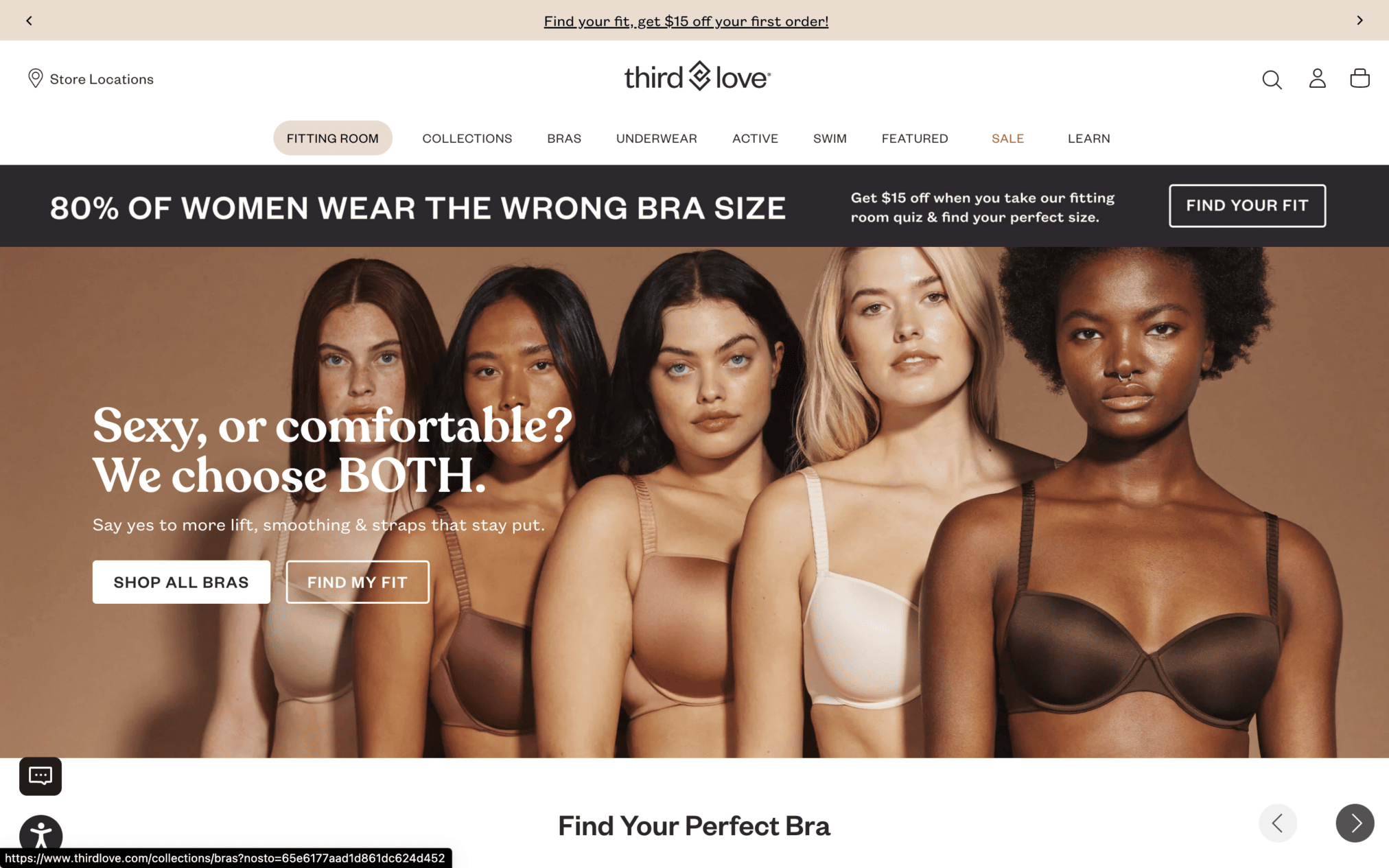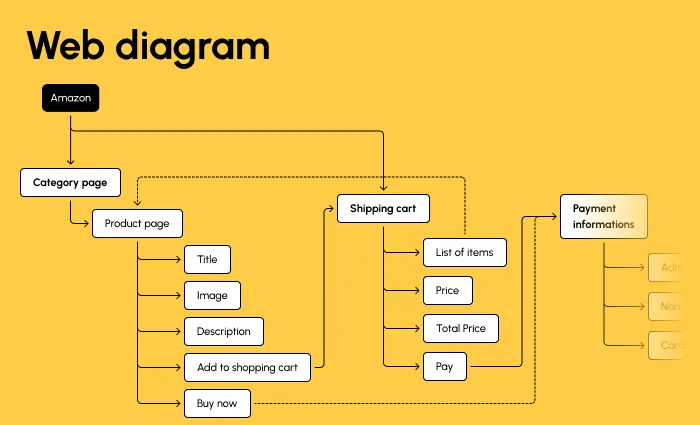What is B2C Web Design & It’s Importance?
B2C website design is the process of designing websites for businesses that sell products/services directly to individual customers. “B2C” stands for “Business-to-Consumer.” It is an eCommerce model where transactions happen directly between businesses and individual consumers. B2C websites play crucial roles in these transactions.
B2C companies use them to showcase their products, establish trust with shoppers, and reach wider audiences. B2C web design experts and agencies help B2C businesses achieve these objectives by crafting digital experiences that convert website visitors into customers.
Let us dive deep into the world of B2C website design and explore its importance in today’s global B2C eCommerce market. We will also discuss real-world B2C website examples, highlighting the strategic design choices, approaches, and elements that differentiate the winners from the pack.
Understanding B2C Web Design and Its Importance

Any badly designed website that looks unappealing and has issues like confusing layouts or slow load time will fail to attract and retain users. Such errors can be fatal for B2C businesses. Their websites are their digital storefronts, their main sources of income. Without high-quality websites, their sales will fall and their online presence will weaken.
As a result, their brand recognition will go down and they will have no chance of connecting or building rapport with their target customers. The global B2C eCommerce market was valued at approximately $5.8 trillion in 2023. With so much money at stake, it is no surprise that the current B2C landscape is hyper-competitive.
To stand out from the crowd, B2C brands must deliver incredible online shopping experiences. To do so, they need top-quality websites that deliver seamless online shopping experiences across all devices. That is what B2C web design experts and agencies specialize in:
- Designing B2C websites that deliver immersive digital experiences, captivate visitors and convert them into paying customers.
- They make B2C sites fast-loading, intuitive, mobile-friendly, and easy to navigate.
- They add compelling visuals, personalized content, detailed product descriptions, and various other engaging, user-centric design elements to B2C sites.
These qualities empower B2C sites, helping them solidify user trust, secure higher conversion rates, and drive sales. A robust online presence also sets the right tone for the brand image among the right audiences. B2C web designers leverage user data to personalize user experiences and journeys on B2C sites.
They leverage user data to create and share personalized content, make appropriate design decisions, and offer other custom-designed perks. For example, Third-Love is a B2C underwear brand that caters to women of different body types and shapes.

This B2C site features friendly, approachable language that is free of shaming/judgment and focused on emphasizing comfort and individual preferences. Product recommendations are based on individual measurements/preferences avoiding the one-size-fits-all approach.
The site is minimalistic, easy to navigate, and packed with informative articles on bra-fitting, different underwear styles, different body types, etc. This B2C website is designed for a specific target audience. Hence, it is successful in offering highly personalized and highly memorable experiences. But, personalization is not enough.
The Current State of B2C Web Design
B2C web design pros are also masters of search engine optimization. They optimize B2C sites for search engine visibility through strategic keyword usage, targeted content creation, and adding relevant and functioning backlinks to the sites. That’s not all. In 2024, these are just the most basic responsibilities of a professional B2C website design agency.
- With mobile eCommerce booming, mobile-optimized UX and responsive design have become non-negotiables for new-age B2C sites. B2C web design agencies help B2C brands make this critical transition from desktop-only to mobile-first.
- They also help B2C sites fiercely vie for customer attention in today’s over-crowded B2C e-commerce space. Standing out from the crowd requires constant design innovation, content optimization, and the consistent refinement of user experiences on the sites.
- New design technologies and trends are emerging all the time. Designers help B2C brands make their sites adapt and evolve with these trends, giving them higher chances of impressing and converting new-age customers.
This whole process: from setting up, formatting, and designing a B2C website to making it function properly and delivering seamless user experiences consistently, falls under the umbrella of B2C website design.
That is why, it is fair to say that for all B2C brands, investing in high-quality B2C web design is vital for survival and success. Until your B2C website, i.e., the first place where users go to find out about your B2C brand, is well-designed, no other digital marketing effort will matter.
Every potential lead will leave disappointed and their negative ‘first experiences’ with your B2C brand will deter other users from visiting. Thankfully, a professional B2C website design agency can easily help any B2C brand avoid such a fate. Here is how.
How Can High-Quality B2C Web Design Help B2C Brands?
For a B2C website to be successful, it must fulfill user needs by delivering seamless experiences while influencing them to take desired actions (i.e., ‘convert’ and make purchases). To achieve this, designers add various features and elements to B2C sites, including:
- Responsive website layouts
- Intuitive navigation
- High-quality, SEO-optimized, and scannable content
- Fast-loading web pages (especially the homepage, the payment pages, and the product/service pages)
- Personalized user journeys, user account pages, and other user-centric design elements
- Friction-free shopping cart and checkout processes with multiple payment options
- Clear calls-to-action that appeal to user logic and emotions, spread all across the site
Here is how professional web design agencies add all of these features and qualities to B2C websites:
1. Implement Intuitive Navigation and Create a Clear Information Architecture

B2C websites often feature thousands of products/services. Without a clear information architecture, it would be impossible for the site to effectively display all of these items, share product-related content, facilitate effortless navigation, and deliver satisfactory shopping experiences. A single misstep in the IA can disrupt the users’ navigational flow and compel them to click that dreaded “exit” button. That is why creating a logical, well-structured IA is one of the first things B2C web designers do. Here are the key components of an effective IA:
- Organized Content: Structured product, service, and content categories, hierarchies, and groupings for easy findability.
- Navigation: Clear and intuitive menu structure full of functional links, product/service filters, and other relevant user pathways. The site should also feature robust search functionalities.
- Labeling: Clear and intuitive labels for all categories, menus, and page titles.
By creating a refined IA, web designers can present company-related information logically and intuitively. Predictable menus, easy-to-use search functionalities, and systematized web pages make navigation a breeze and all of this builds customer loyalty. Amazon is the perfect example of a B2C site efficiently leveraging efficient IA and navigation design.
While many B2C sites drown in product and feature overload, Amazon thrives thanks to its meticulously crafted information architecture (IA):

As you can see, the architecture of each info-set, each menu, category, and product page is highly comprehensive yet clear and uncluttered. They are all logically organized into intuitive categories and subcategories. Inside each of these subcategories, items are listed with descriptive and unambiguous titles that are used consistently across the site.
2. Responsive Design

To help B2C brands adapt to this mobile-first world, designers create responsive web designs. A responsive B2C web design can dynamically transform across different devices/screens (smartphones, tablets, etc.), seamlessly adapting its layout, structure, and size. Such responsive B2C sites deliver optimal shopping experiences to mobile users who represent 58.67% of all global website traffic.
3. Page Speed Optimization
New-age shoppers expect B2C and eCommerce sites to load within seconds. To meet these expectations leading B2C and eCommerce web design pros have embraced micro-speed optimization:
- Code Minification: All unnecessary characters/formatting from HTML, CSS, JavaScript, etc., are stripped and deleted, resulting in B2C websites with leaner code that downloads faster.
- Media Optimization: Images, videos, and other bulky multimedia content are compressed to ensure all web pages load fast.
- Caching: Identify frequently used/accessed design elements (product images, navigation menus) and cache them.
4. Color Psychology

It is important to align your B2C website’s color with your brand colors. But, the website should not mimic corporate palettes completely. For example, Sephora’s brand colors are classic black-and-white with other subtle tones as an accent colors:

These hues evoke class and calm, perfectly aligning with the type of shopping experience Sephora’s target audience (beauty enthusiasts) would like. B2C web designers assess their target customer base’s values, needs, and emotional triggers.
Then, they chart out the emotional journey that they want visitors to experience while browsing the site. Then, they pick appropriate colors. Here is how different color families prompt different types of emotional journeys:
- Yellow: Beams with optimism, intelligibility, and warmth
- Orange: Bursts with friendly energy, playful confidence, and a dash of citrusy zest
- Red: Excitement, youthful vibrancy, and a touch of boldness
- Blue: Inspires trust, reflects dependability, and exudes calmness
- Green: Whispers peace, growth, health, and wisdom
5. Omnidirectional Customer Education

Professional B2C web designers do not dive into the visual vs. textual learners’ debate. Their designs deliver multimodal learning experiences that cater to visual, textual, and kinesthetic learners alike. In simpler terms, their designs are neither too text-heavy nor too visual-focused. Instead, they take a balanced approach by packing their designs with elements like:
- High-definition images
- Interactive 3D models
- Detailed product specs
- In-depth reviews
- Explainer videos
This balanced, omnidirectional design approach ensures that every user, irrespective of their learning style, feels welcome on the B2C website.
6. Tailored Journeys and Different Funnels
As explained in the last point, B2C brands should never fall into the trap of designing their websites for one specific user base. Instead, they should design their websites in a way that dynamically funnels different user groups to different website sections.
Think of it like navigating a physical store: regular shoppers will confidently go to specific stalls whereas first-time visitors will wander around, exploring different products. Your website should mirror this dynamic funneling:
| B2C Website Element | How to Appeal to Seasoned Customers | How to Appeal to Potential Customers |
| Homepage | – Direct them to best-selling products – Display special offers – Share clear CTAs | – Share informative content – Display engaging product visuals – Direct toward the brand story section |
| Product Exploration | – Share personalized recommendations | – Blogs, articles, case studies – Pages like ‘most popular products’ |
| Navigation | – Intuitive structure – Easy search – Easy FAQs | – Pack their journey with educational resources – Make sure they come across testimonials and lead-capture forms |
The eyewear brand Warby Parker has always been a master of omnichannel retailing and personalization. On their B2C site, newcomers are greeted with contests that ask them to share their eyewear styles and needs whereas returning users receive personalized product suggestions and streamlined checkout experiences right away:

B2C Website Design at Design Studio
B2C design is a multifaceted process, encompassing various elements like UX design, content creation, conversion optimization, and more. We have only covered the basics in this article. If you want to learn more about how we craft B2C websites that convert, engage, and captivate, let’s talk! At Design Studio, we specialize in creating high converting UI experiences that drive real results. Connect with our team today—just drop us a query, and we’ll get back to you with a tailored solution right away!

comments
Add comment